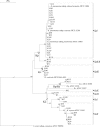Identification of clinical isolates of indole-positive and indole-negative Klebsiella spp
- PMID: 16928968
- PMCID: PMC1594763
- DOI: 10.1128/JCM.00940-06
Identification of clinical isolates of indole-positive and indole-negative Klebsiella spp
Abstract
Biochemical methods employed to classify bacterial species have limitations and may have contributed to the taxonomic complexity recently reported for the genus Klebsiella. The objective of the present study was to apply a simple biochemical test panel to classify a collection of human Klebsiella isolates. We found that with only three additional tests, it is possible to place most isolates in a defined species. Analysis of a 512-bp sequence of the rpoB gene was used as the reference. A total of 16 conventional and 4 supplementary tests were used to evaluate 122 recent isolates identified as Klebsiella from 120 patients, isolated at the clinical laboratory of a university hospital in Minas Gerais, Brazil. Of these, 102 (84%) isolates were identified as Klebsiella pneumoniae or Klebsiella variicola, 19 (15%) as Klebsiella oxytoca, and 1 (1%) as Raoultella planticola. Enterobacterial repetitive intergenic consensus-PCR typing revealed a diversity of genotypes. rpoB gene sequencing confirmed the phenotypic identification and detected five K. variicola isolates among the K. pneumoniae/K. variicola group. Three additional tests that include growth at 10 degrees C and histamine and d-melezitose assimilation should be considered essential tests for the typing of Klebsiella isolates.
Figures

References
-
- Arakawa, Y., M. Ohta, N. Kido, Y. Fujii, T. Komatsu, and N. Kato. 1986. Close evolutionary relationship between the chromosomally encoded β-lactamase gene of Klebsiella pneumoniae and the TEM β-lactamase gene mediated by R plasmids. FEBS Lett. 207:69-74. - PubMed
-
- Biedenbach, D. J., G. J. Moet, and R. N. Jones. 2004. Occurrence and antimicrobial resistance pattern comparisons among bloodstream infection isolates from SENTRY Antimicrobial Surveillance Program. Diagn. Microbiol. Infect. Dis. 50:59-69. - PubMed
-
- Boye, K., and D. S. Hansen. 2003. Sequencing of 16S rDNA of Klebsiella: taxonomic relations within the genus and to other Enterobacteriaceae. Int. J. Med. Microbiol. 292:495-503. - PubMed
-
- Brisse, S., and E. Duijkeren. 2005. Identification and antimicrobial susceptibility of 100 Klebsiella animal clinical isolates. Vet. Microbiol. 105:307-312. - PubMed
Publication types
MeSH terms
Substances
Associated data
- Actions
- Actions
- Actions
- Actions
- Actions
- Actions
- Actions
- Actions
- Actions
- Actions
- Actions
- Actions
- Actions
- Actions
- Actions
- Actions
- Actions
- Actions
- Actions
- Actions
- Actions
- Actions
- Actions
- Actions
- Actions
- Actions
- Actions
- Actions
- Actions
- Actions
- Actions
- Actions
- Actions
- Actions
- Actions
- Actions
- Actions
- Actions
- Actions
- Actions
- Actions
- Actions
- Actions
- Actions
- Actions
- Actions
- Actions
- Actions
Grants and funding
LinkOut - more resources
Full Text Sources
Other Literature Sources
Molecular Biology Databases
Miscellaneous

